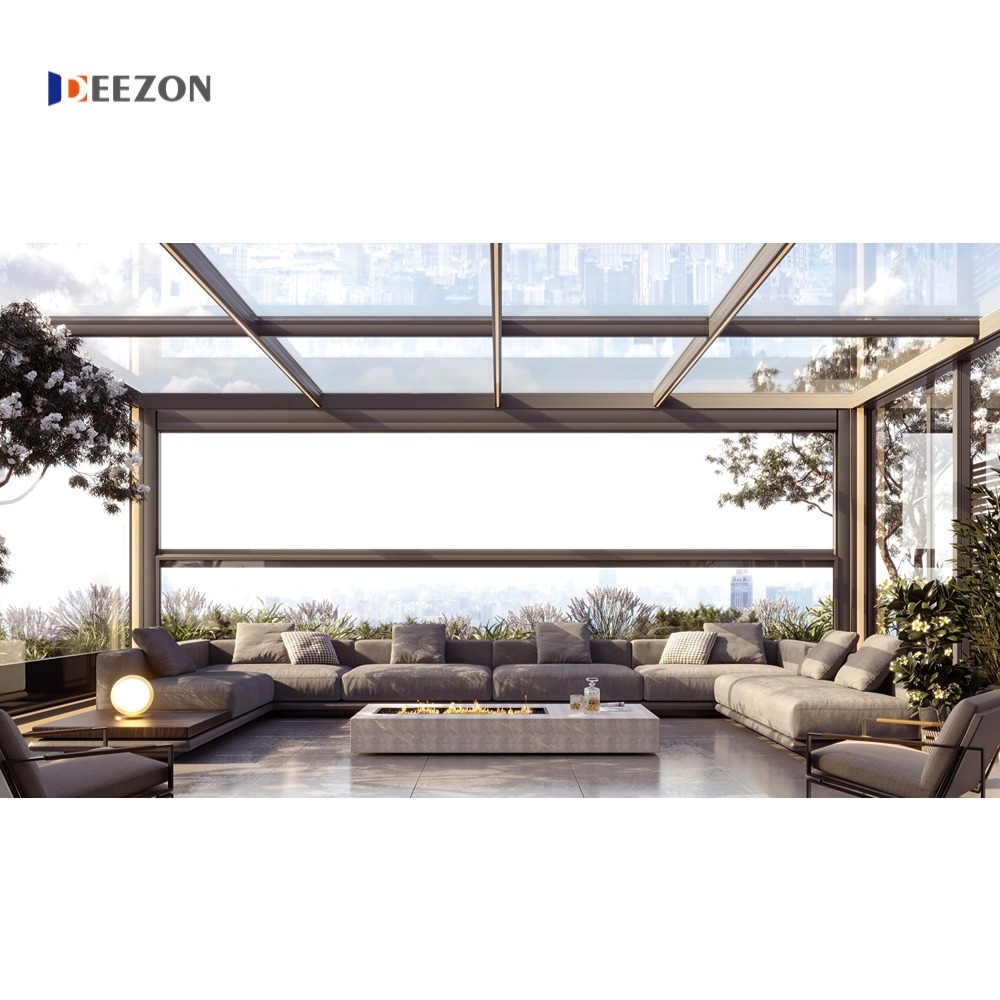Foshan Deezon Windows and Doors Co.,Ltd.
Exploring Different Roof Styles for Your Conservatory Greenhouse
Apr 22,2025

Exploring Different Roof Styles for Your Conservatory Greenhouse
When it comes to creating the perfect conservatory greenhouse, the roof style plays a pivotal role in both functionality and aesthetic appeal. A well-designed roof not only enhances the overall architecture of your space but also contributes significantly to energy efficiency, light distribution, and ventilation for your plants. In this comprehensive guide, we will delve into various roof styles for conservatory greenhouses, examining their benefits, design elements, and how to choose the right one for your needs.
Table of Contents
- Understanding the Role of a Greenhouse Roof
- Traditional Roof Styles for Conservatories
- Modern Roof Designs for Greenhouses
- Energy-Efficient Roofing Options
- The Impact of Roof Angle and Slope
- Ventilation and Lighting Considerations
- Choosing the Right Roof for Your Greenhouse
- Frequently Asked Questions About Greenhouse Roofs
Understanding the Role of a Greenhouse Roof
The roof of your conservatory greenhouse serves several critical functions. First and foremost, it protects your plants from harsh weather conditions, such as heavy rain and snow. Additionally, the roof plays a significant role in light infiltration, which is essential for plant growth. Different materials and designs can affect how much light enters your greenhouse, impacting your plants' health and productivity.
Moreover, a well-designed roof can aid in temperature regulation. By selecting appropriate materials and styles, you can enhance the greenhouse's thermal efficiency, allowing for a more stable and controlled environment. This is particularly important for maintaining the right climate for various plant types.
Traditional Roof Styles for Conservatories
Traditional roof styles often evoke a sense of nostalgia and charm, making them a popular choice for homeowners looking to create a classic greenhouse aesthetic. Here are some prominent traditional roof styles:
Gable Roof
The gable roof is one of the most common styles for conservatories. Characterized by its triangular shape, this design allows for excellent air circulation and natural light penetration. Gable roofs can also be easily constructed with various materials, such as glass or polycarbonate panels, providing versatility in design.
Hip Roof
A hip roof features slopes on all four sides, which can provide a more stable structure compared to gable roofs. This style is particularly beneficial in areas prone to heavy snowfall, as the sloping design allows snow to slide off easily. Hip roofs also provide a cozy, enclosed feeling while maximizing light exposure.
Lean-To Roof
The lean-to roof is a simple, functional style that leans against an existing wall or structure. This design is ideal for smaller spaces and offers a modern twist on traditional greenhouse roofing. Lean-to roofs can maximize light exposure by being positioned south-facing, making them perfect for maximizing sunlight throughout the day.
Modern Roof Designs for Greenhouses
As architectural trends evolve, so do greenhouse roof designs. Modern styles often prioritize sleek aesthetics and innovative materials. Here are some contemporary roof options:
Curved Roof
Curved roofs offer a unique, flowing design that distinguishes itself from traditional angular styles. The curvature allows for even light distribution and can reduce wind resistance, making it an ideal choice for areas with high winds. Furthermore, curved roofs can create a striking visual appeal, enhancing the overall design of the greenhouse.
Flat Roof
Flat roofs are often favored for their minimalist appearance and ease of construction. While they may not provide as much headroom as other styles, they offer a modern aesthetic that can complement contemporary homes. Adding skylights or green roofing systems can enhance their functionality, promoting sustainable practices while allowing light into the greenhouse.
Segmented Roof
Segmented roofs consist of multiple sections that can be designed in various shapes and angles. This design allows for creative customization while maintaining structural integrity. The segmentation can facilitate better ventilation and light entry by adjusting the angles of different sections.
Energy-Efficient Roofing Options
Choosing energy-efficient roofing materials is crucial for creating a sustainable greenhouse. Here are some options that not only enhance energy efficiency but also contribute to plant health:
Polycarbonate Panels
Polycarbonate panels are lightweight, durable, and provide excellent insulation properties. They come in various thicknesses, allowing homeowners to choose the right level of thermal efficiency for their greenhouse. Additionally, polycarbonate panels filter harmful UV rays while allowing visible light to penetrate, creating a conducive environment for plant growth.
Glass Roofs
Glass roofs are a classic choice that offers unparalleled aesthetics and light transmission. Modern glass technologies, such as low-emissivity coatings, improve energy efficiency by minimizing heat loss while maximizing light entry. Although glass can be heavier and more expensive, its durability and timeless appeal often make it worthwhile.
Green Roofs
Green roofs, covered with vegetation, provide natural insulation and improve the overall environmental footprint of your greenhouse. They not only help regulate temperature but also manage stormwater and enhance biodiversity. Adopting a green roof design can create a unique ecosystem, benefiting both plants and wildlife.
The Impact of Roof Angle and Slope
The angle and slope of your greenhouse roof significantly influence light capture and water drainage. Here’s how to consider these factors in your design:
Optimal Angle for Sunlight
The angle of your roof should be adjusted based on your geographical location to maximize sunlight exposure throughout the year. In areas closer to the poles, a steeper angle is often beneficial to capture sunlight during the winter months, while areas nearer the equator may benefit from a gentler slope to avoid overheating.
Effective Water Drainage
A proper roof slope is vital for effective drainage, preventing water accumulation that could lead to structural damage or mold growth. A slope of at least 15 degrees is generally recommended for efficient drainage. Designing your roof with the right angle can enhance its durability and longevity.
Ventilation and Lighting Considerations
Effective ventilation and lighting are essential for maintaining optimal conditions in your conservatory greenhouse. Here are some important considerations:
Natural Ventilation Systems
Incorporating roof vents and louvered windows can facilitate natural airflow, promoting a healthy growing environment. Strategically placing vents at different heights can create cross-ventilation, helping to regulate temperature and humidity levels.
Artificial Lighting Solutions
While natural light is critical, supplementing with artificial lighting can enhance plant growth, especially during shorter days. Consider integrating LED grow lights into your design to extend the growing season and optimize plant health.
Choosing the Right Roof for Your Greenhouse
When selecting the perfect roof style for your conservatory greenhouse, several factors must be considered:
Climate Considerations
Understanding your local climate is crucial. Areas with heavy snowfall may require sturdier designs, such as hip or gable roofs, while regions with high winds might benefit from curved roofs. Knowing how the climate affects your greenhouse will guide your decision.
Budget and Material Preferences
Your budget will ultimately dictate your roofing options. While glass offers a luxurious look, polycarbonate is often more budget-friendly and energy-efficient. Consider the long-term benefits of your investment when making your choice.
Aesthetic Compatibility
Ensure that your roof style complements the architecture of your home. A cohesive design will enhance the property’s overall appeal and value. Whether you prefer a classic look or a modern twist, the roof should harmonize with your existing structures.
Frequently Asked Questions About Greenhouse Roofs
1. What is the best roofing material for a greenhouse?
The best roofing material depends on your climate, budget, and aesthetic preferences. Glass, polycarbonate, and fiberglass are popular options, each with unique benefits.
2. How much light do plants need in a greenhouse?
Most plants require at least 6 to 8 hours of light daily. Choosing a roof that maximizes light infiltration is crucial to their growth and health.
3. Can I install a green roof on my greenhouse?
Yes, green roofs can be installed on greenhouses, provided the structure is strong enough to support the additional weight. They offer excellent insulation and environmental benefits.
4. How do I maintain my greenhouse roof?
Regular maintenance includes cleaning the roof to remove debris and checking for any damage or leaks. For glass roofs, use a soft cloth and mild cleaning solution to avoid scratches.
5. What is the best angle for a greenhouse roof?
The best angle for a greenhouse roof depends on your location. A steeper angle is generally better for colder climates, while a gentler slope is suitable for warmer areas.
Conclusion
Choosing the right roof style for your conservatory greenhouse is essential for creating a thriving environment for your plants. By understanding the various styles available, their benefits, and how they interact with light and ventilation, you can make an informed decision that aligns with your aesthetic desires and functional needs. Whether you lean towards traditional designs or modern structures, the perfect roof is out there waiting to enhance your greenhouse experience. Remember, the right roof not only elevates the beauty of your conservatory but also significantly impacts the health and productivity of your plants.







